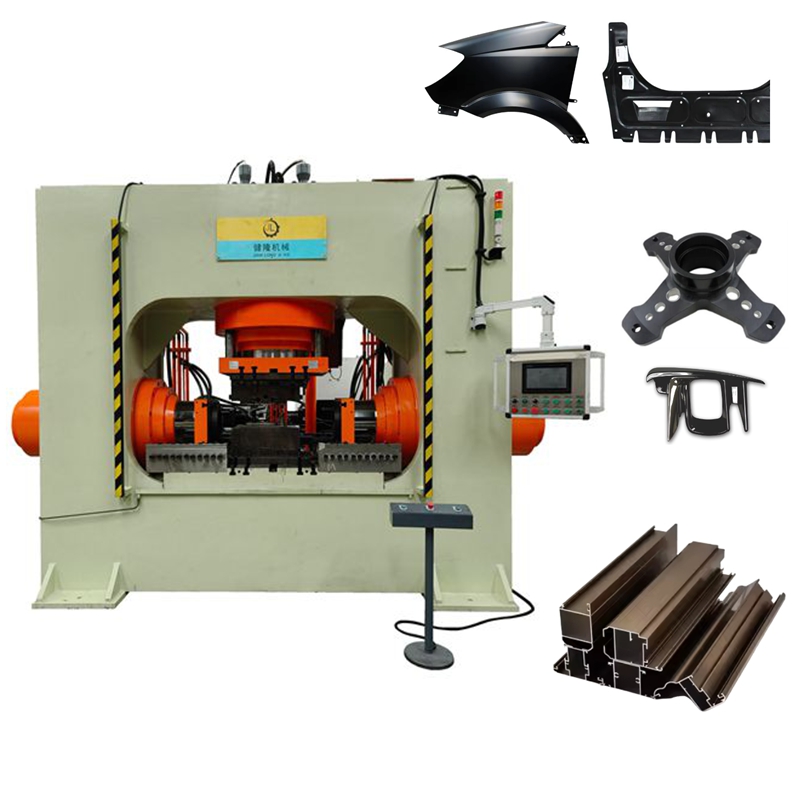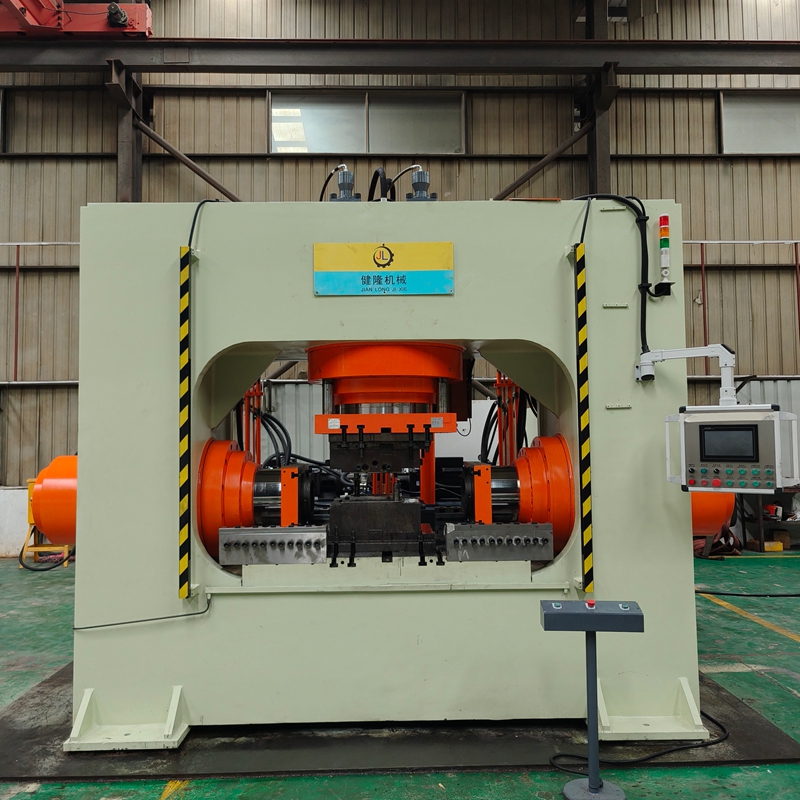The process flow of a forging hydraulic press is a systematic project, requiring multiple precisely controlled stages from raw materials to the final product. Below is a summary shared by Jianlong Hydraulic Technology for your reference!

1. Blanking
1.1 Purpose: To cut raw long bars (round steel, square steel, etc.) into blanks of the required size and weight for forging.
1.2 Methods:
1.2.1 Sawing: Using circular saws, band saws, etc., produces a smooth cut and high precision, making it the most common method.
1.2.2 Shearing: Using a shearing machine, it is highly efficient, but the cut quality is slightly inferior, generally used for small-sized blanks or those with less stringent requirements.
1.2.3 Flame/Plasma Cutting: Mainly used for cutting large steel ingots.
1.3 Requirements: Accurate weight, regular shape, preparing for subsequent heating and forging.
2. Heating
2.1 Purpose: To heat the billet to the forging temperature (usually above the recrystallization temperature of the metal) to improve its plasticity, reduce its resistance to deformation, and make it easier to form.
2.2 Heating Temperature: Depends on the material type, for example:
2.2.1 Carbon steel: Typically 1100 ~ 1250°C
2.2.2 Alloy steel: Similar temperature range, but requires stricter control
2.2.3 Aluminum alloy: Generally 400 ~ 500°C
2.2.4 Titanium alloy: Generally 850 ~ 950°C
2.3 Equipment: Pusher furnace, walking beam furnace, induction heating furnace, etc. Induction heating is fast and produces less oxidation, making it the preferred choice for modern automated production lines.
3. Forging
This is the core forming process. As shown in the diagram, it comprises multiple steps, typically completed in one operation on a hydraulic press:
3.1 Upsetting: The billet is compressed axially, reducing its height and increasing its cross-section. The purpose is to break up the as-cast structure, eliminate defects, and distribute material for subsequent steps.
3.2 Pre-forging (or rough forging): This initially forms the approximate shape of the forging, ensuring proper metal distribution and preparing for final forging. It determines the metal flow and filling pattern.
3.3 Final Forging: In a precision final forging die cavity, the billet is completely filled, achieving a shape, size, and surface detail very close to the finished part.
3.4 Trimming/Punching: After final forging, the forging will have a burr around its edge, and there may be a thin layer in the center (for forgings with holes). This needs to be removed using trimming and punching dies.
4. Heat Treatment
4.1 Purpose: To eliminate internal stress generated during forging, refine uneven microstructure, and adjust and improve the comprehensive mechanical properties of forgings (such as strength, hardness, and toughness) to meet design drawing requirements.
4.2 Main Methods:
4.2.1 Normalizing: Refines grain size, homogenizes microstructure, and improves machinability.
4.2.2 Quenching and Tempering (Quenching + High-Temperature Tempering): Obtains comprehensive mechanical properties combining high strength and good toughness, widely used in important components such as automotive connecting rods and crankshafts.
4.2.3 Annealing: Reduces hardness, eliminates internal stress, and facilitates machining.
5. Cleaning and Finishing
5.1 Purpose: To remove oxide scale, oil stains, etc. from the surface of forgings and correct deformation to obtain a clean, dimensionally correct surface.
5.2 Methods:
5.2.1 Shot Blasting/Sandblasting: Utilizes high-speed shot to impact the surface of forgings, thoroughly removing oxide scale and rust, and creating compressive stress to improve fatigue strength. 5.2.2 Pickling: Chemical removal of oxide scale.
5.2.3 Correction: Cold or hot correction of forgings deformed during heat treatment or processes to ensure their shape and dimensional tolerances.
6. Inspection
This is the final checkpoint to ensure product quality and is integral to the entire process.
6.1 Contents:
6.1.1 Visual Inspection: Visually inspecting for surface defects such as cracks, folds, and pits using tools.
6.1.2 Dimensional Inspection: Using calipers, templates, and coordinate measuring machines (CMMs) to check whether critical dimensions are within tolerance ranges.
6.1.3 Mechanical Property Inspection: Taking samples from the forging itself or accompanying specimens for tensile, impact, and hardness tests.
6.1.4 Non-destructive Testing: Using ultrasonic testing (UT) to detect internal defects; magnetic particle testing (MT) or penetrant testing (PT) to detect surface and near-surface defects.
6.1.5 Metallographic Analysis: Inspect the microstructure of the material to ensure it meets specifications.

The entire process is interconnected, and precise control at each stage collectively determines the quality and performance of the final forging. Modern forging hydraulic press production lines are highly automated, integrating the above-mentioned processes to achieve efficient, stable, and high-quality production. For more information/advice on forging hydraulic presses or to purchase other high-quality hydraulic presses, please contact us (or scan the WhatsApp QR code below). Jianlong Hydraulic Technology will provide you with personalized and customized professional solutions and is dedicated to serving you.

Contact: Miss.Li
Phone: 18822971180
Tel: 86-18822971180
Email: lifuyan78@gmail.com
Add: Guangyi Industrial Park, No. 2, Tanglip Jinfu West Road, Liaobu Town, Dongguan City, China
We chat
